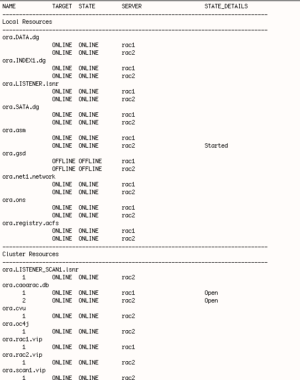1. Exibir a configuração atual do scan.
$ srvctl config scan SCAN name: exadata-pscan1, Network: 1 Subnet IPv4: 192.168.16.0/255.255.255.0/bondeth0, static Subnet IPv6: SCAN 0 IPv4 VIP: 192.168.16.43 SCAN VIP is enabled. SCAN VIP is individually enabled on nodes: SCAN VIP is individually disabled on nodes: SCAN 1 IPv4 VIP: 192.168.16.41 SCAN VIP is enabled. SCAN VIP is individually enabled on nodes: SCAN VIP is individually disabled on nodes: SCAN 2 IPv4 VIP: 192.168.16.42 SCAN VIP is enabled. SCAN VIP is individually enabled on nodes: SCAN VIP is individually disabled on nodes:
2. Obter informações sobre registros de DNS do SCAN.
$ nslookup exadata-pscan1 Server: 192.168.16.20 Address: 192.168.16.20#53 Name: exadata-pscan1 Address: 192.168.16.41 Name: exadata-pscan1 Address: 192.168.16.42 Name: exadata-pscan1 Address: 192.168.16.43
Onde: 192.168.16.41, 192.168.16.42 e 192.168.16.43 são os IPs do SCAN
3. Nome do Cluster.
$./olsnodes -c exadata-pclu1
4) Exibir o nome do Node Público e Privado
$ cd /u01/app/12.1.0.2/grid/bin/ $ ./olsnodes -n -i exadatadm01vm011exadata01vm01-vip exadatadm02vm012exadata02vm01-vip $./srvctl config nodeapps -a Network 1 exists Subnet IPv4: 192.168.16.0/255.255.255.0/bondeth0, static Subnet IPv6: Ping Targets: Network is enabled Network is individually enabled on nodes: Network is individually disabled on nodes: VIP exists: network number 1, hosting node exadatadm01vm01 VIP Name: exadata01vm01-vip VIP IPv4 Address: 192.168.16.46 VIP IPv6 Address: VIP is enabled. VIP is individually enabled on nodes: VIP is individually disabled on nodes: VIP exists: network number 1, hosting node exadatadm02vm01 VIP Name: exadata02vm01-vip VIP IPv4 Address: 192.168.16.47 VIP IPv6 Address: VIP is enabled. VIP is individually enabled on nodes: VIP is individually disabled on nodes:
5) Exibe informações do IP privado.
$./olsnodes -n -i -l -p exadatadm01vm011172.16.2.63exadata01vm01-vip
As informações de rede pública e privada são armazenadas no Oracle Cluster Registry (OCR).
$./oifcfg getif bondeth0 192.168.16.0 global public ib0 172.16.0.0 global cluster_interconnect
“cluster_interconnect” — Interface Privada no Oracle Clusterware
O comando iflist consulta o sistema operacional para descobrir quais interfaces de rede estão presentes no node.
O comando iflist mostra as interfaces disponíveis que você pode configurar com o “setif”.
-p exibe o tipo de interface que pode ser PRIVATE, PUBLIC ou UNKNOWN
-n inclui a máscara de sub-rede
$ ./oifcfg iflist -p -n eth0 192.168.1.0 PRIVATE 255.255.255.0 bondeth0 192.168.16.0 PRIVATE 255.255.255.0 bondeth1 10.70.156.0 PRIVATE 255.255.255.0 ib0 172.16.0.0 PRIVATE 255.255.252.0 ib0 169.254.0.0 UNKNOWN 255.255.0.0 ib1 172.16.0.0 PRIVATE 255.255.252.0
6) Configuração da interface de Rede
$ ifconfig |grep 192.168* Ifconfig uses the ioctl access method to get the full address information, which limits hardware addresses to 8 bytes. Because Infiniband address has 20 bytes, only the first 8 bytes are displayed correctly. Ifconfig is obsolete! For replacement check ip. Ifconfig uses the ioctl access method to get the full address information, which limits hardware addresses to 8 bytes. Because Infiniband address has 20 bytes, only the first 8 bytes are displayed correctly. Ifconfig is obsolete! For replacement check ip. Ifconfig uses the ioctl access method to get the full address information, which limits hardware addresses to 8 bytes. Because Infiniband address has 20 bytes, only the first 8 bytes are displayed correctly. Ifconfig is obsolete! For replacement check ip. inet addr:192.168.16.44 Bcast:192.168.16.255 Mask:255.255.255.0 inet addr:192.168.16.46 Bcast:192.168.16.255 Mask:255.255.255.0 inet addr:192.168.16.41 Bcast:192.168.16.255 Mask:255.255.255.0 inet addr:192.168.16.42 Bcast:192.168.16.255 Mask:255.255.255.0 inet addr:192.168.1.82 Bcast:192.168.1.255 Mask:255.255.255.0
Onde:
192.168.16.44 — IP de dados
192.168.16.46 — IP do VIP
192.168.16.41 — IP do SCAN
192.168.16.42 — IP do SCAN
192.168.1.82 — IP de Gerência
Referência
Clusterware Administration and Deployment Guide. Avalilable at: https://docs.oracle.com/cd/B28359_01/rac.111/b28255/oifcfg.htm
